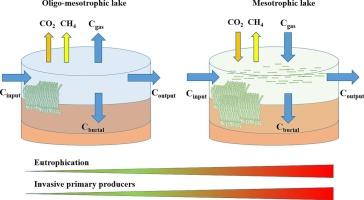入侵初级生产者调节温带浅湖的碳通量和相关的碳收支
IF 8
1区 环境科学与生态学
Q1 ENVIRONMENTAL SCIENCES
引用次数: 0
摘要
低地浅湖是集水区养分和有机碳的接收环境。在温带地区,营养物质和温和温度的协同作用诱导这些系统的碳排放。然而,这种趋势可能受到湖泊的营养状况及其生产力的调节。在这项研究中,我们认为入侵水下水生植被(SAV)和蓝藻的大量繁殖是富营养化的一个有价值的代理,并探讨了它们在温带浅湖碳库和相关预算中的作用。基于年碳库(输入、输出、气体交换、埋藏)和水生代谢,计算了两个以不同营养状态为特征、被不同程度入侵的SAV和蓝藻占领的大型浅湖的质量碳收支。中营养型湖泊作为CO2和CH4的年源(81.2±14.8 g C m−2 yr−1),主要是由于底栖生物的异养代谢,而中营养型湖泊作为年汇(- 6.7±9.7 g C m−2 yr−1),主要是由于入侵的SAV和蓝藻的净碳吸吸量要高得多。在中营养型湖泊中,入侵原生生物的快速代谢也使湖泊的碳输出具有较强的缓冲能力。我们的研究强调了沿海湖泊带在控制区域/全球碳循环中发挥的主要作用,特别是在密集植被系统中。我们认为富营养化和生物入侵之间的相互作用可以将湖泊从碳源转变为碳汇。本文章由计算机程序翻译,如有差异,请以英文原文为准。

Invasive primary producers modulate carbon fluxes and associated carbon budgets in temperate shallow lakes
Lowland shallow lakes are the receiving environments of nutrients and organic carbon from the catchment area. In temperate areas, the synergic action of nutrients and mild temperatures induce carbon emissions from these systems. However, this trend might be modulated by the trophic state of lakes and by their productivity. In this study, we consider blooms of invasive submerged aquatic vegetation (SAV) and cyanobacteria as a valuable proxy for eutrophication and explore their role in carbon pools and associated budgets in temperate shallow lakes. We calculated the mass carbon budget of two large shallow lakes, characterized by different trophic states and colonized by varying degrees of invasive SAV and cyanobacteria, basing on annual carbon pools (input, output, gas exchange, burial) and aquatic metabolism. The oligo-mesotrophic lake behaved as an annual CO2 and CH4 source toward the atmosphere (81.2 ± 14.8 g C m−2 yr−1), mainly due to dominant benthic heterotrophic metabolism, whereas the mesotrophic lake behaved as an annual sink (−6.7 ± 9.7 g C m−2 yr−1), mainly because of a much higher net carbon uptake by invasive SAV and cyanobacteria. In the mesotrophic lake, the fast-growing metabolism of the invasive primary producers also resulted in a strong buffer capacity with respect to the carbon export from the lake. Our study highlights the major role played by the littoral lacustrine zones in the control of regional/global carbon cycle, especially in densely vegetated systems. We suggest that the interplay between eutrophication and biological invasions can switch lakes from carbon source to sink.
求助全文
通过发布文献求助,成功后即可免费获取论文全文。
去求助
来源期刊

Science of the Total Environment
环境科学-环境科学
CiteScore
17.60
自引率
10.20%
发文量
8726
审稿时长
2.4 months
期刊介绍:
The Science of the Total Environment is an international journal dedicated to scientific research on the environment and its interaction with humanity. It covers a wide range of disciplines and seeks to publish innovative, hypothesis-driven, and impactful research that explores the entire environment, including the atmosphere, lithosphere, hydrosphere, biosphere, and anthroposphere.
The journal's updated Aims & Scope emphasizes the importance of interdisciplinary environmental research with broad impact. Priority is given to studies that advance fundamental understanding and explore the interconnectedness of multiple environmental spheres. Field studies are preferred, while laboratory experiments must demonstrate significant methodological advancements or mechanistic insights with direct relevance to the environment.
 求助内容:
求助内容: 应助结果提醒方式:
应助结果提醒方式:


